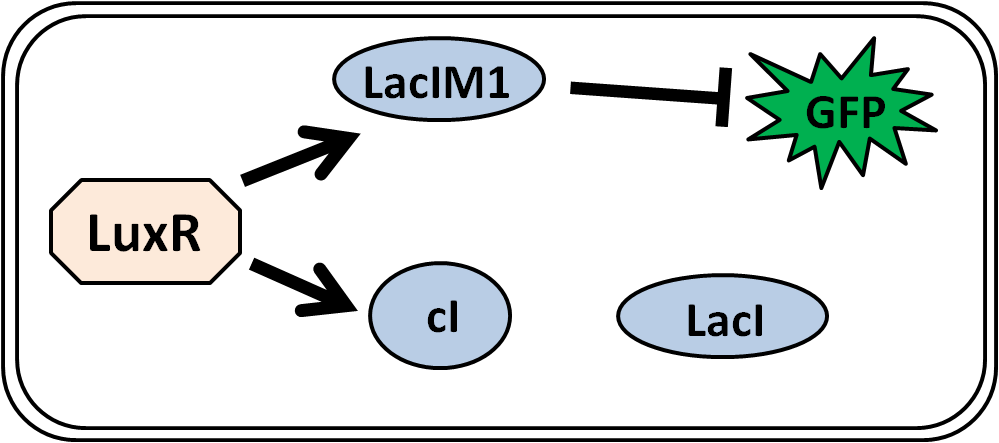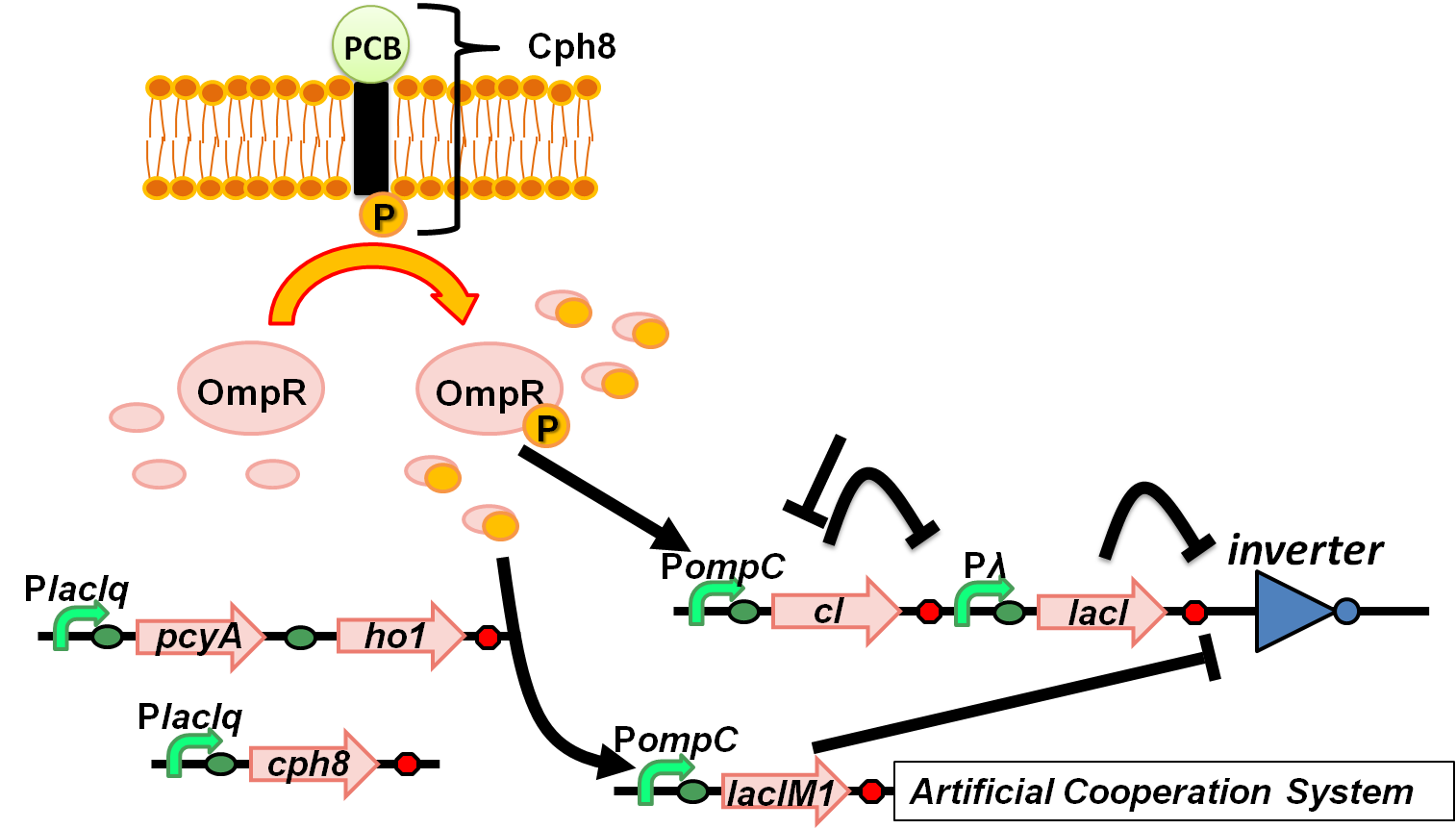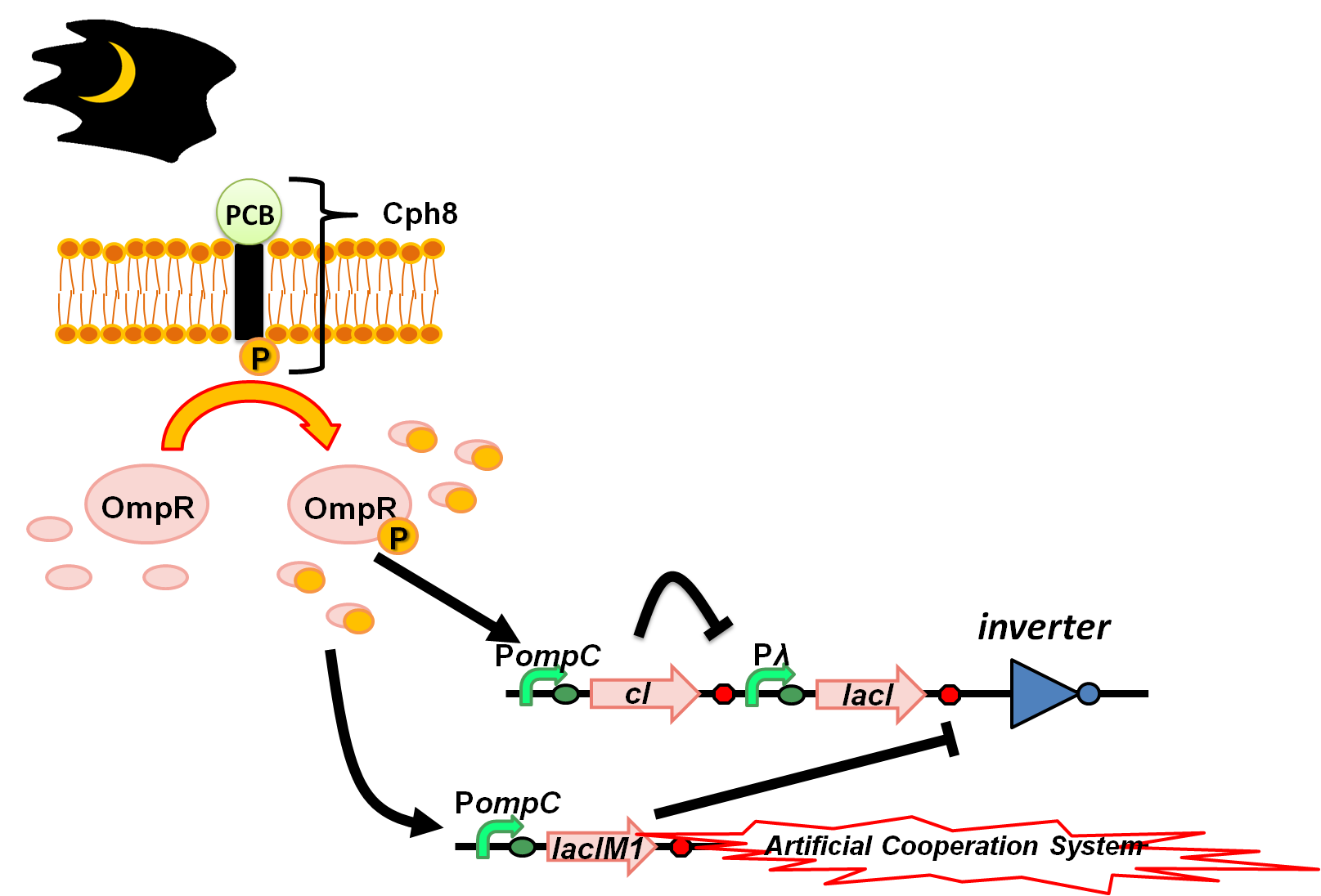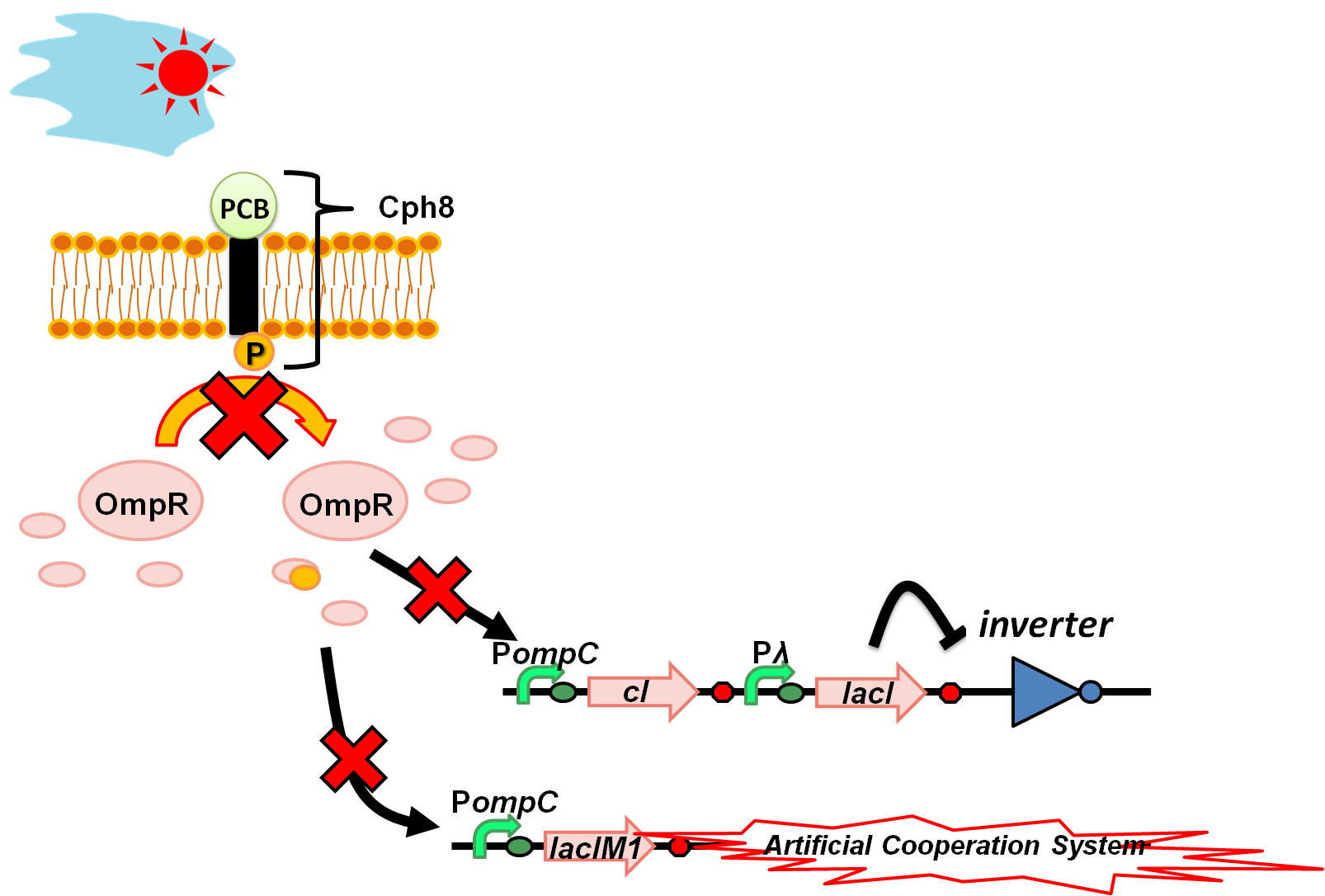Team:Tokyo Tech/Project/wolf coli/System
From 2010.igem.org
| Line 39: | Line 39: | ||
<div id="tf_SubWrapper"> | <div id="tf_SubWrapper"> | ||
<font size="5"><b>4-3 wolfcoli system</b></font> | <font size="5"><b>4-3 wolfcoli system</b></font> | ||
| - | |||
| - | |||
==Red-light-dependent gene expression network== | ==Red-light-dependent gene expression network== | ||
A red-light-dependent gene expression network has been introduced into E. coli [1]. And these BioBrick parts have been registered. | A red-light-dependent gene expression network has been introduced into E. coli [1]. And these BioBrick parts have been registered. | ||
| Line 58: | Line 56: | ||
LuxR activates the expression of cI and LacIM1. LacIM1 shows weaker repression than LacIWT because it has a lower affinity to lac promoter. | LuxR activates the expression of cI and LacIM1. LacIM1 shows weaker repression than LacIWT because it has a lower affinity to lac promoter. | ||
| + | [[Image: tokyotech_bandpass1.png|left|thumb|300px|Figure 4-3-1.Band-detect network ]] | ||
| Line 68: | Line 67: | ||
| + | [[Image: tokyotech_bandpass3.png|left|thumb|300px|Figure 4-3-2.Band-detect network ]] | ||
| - | High concentration of AHL(Fig. 4-3-2a) results in high levels of | + | High concentration of AHL(Fig. 4-3-2a) results in high levels of cI and LacIM1 and repression of GFP. |
| - | At low concentration of AHL(Fig. 4-3-2b), Lac IM1 and | + | At low concentration of AHL(Fig. 4-3-2b), Lac IM1 and cI are expressed only at basal levels. This enables the expression of a LacIWT, again resulting in GFP repression. |
| - | At intermediate concentration of AHL (Fig. 4-3-2c), this results in moderate levels of | + | At intermediate concentration of AHL (Fig. 4-3-2c), this results in moderate levels of cI and LacIM1. However, because the repression efficiency of cI is significantly higher than that of LacIM1, cI effectively shuts off LacI expression while the LacIM1 concentration is below the threshold required to repress GFP production. This difference between the cI and LacIM1 repression efficiencies, in combination with a feed-forward loop that begins with LuxR and culminates in GFP, affords the circuit the desired non-monotonic response to AHL dosages. |
==Genetic circuit== | ==Genetic circuit== | ||
・circuit | ・circuit | ||
| + | [[Image: tokyotech_wolfcoli_system.png|left|thumb|300px|Figure 4-3-3.Wolfcoli system ]] | ||
| + | |||
| Line 93: | Line 95: | ||
We aimed to introduce a red-light-dependent gene expression network and the band-detect network into the Artificial Cooperation System. (Fig. 4-3-3) | We aimed to introduce a red-light-dependent gene expression network and the band-detect network into the Artificial Cooperation System. (Fig. 4-3-3) | ||
| - | Two systems were united by applying OmpR. OmpR usually works as regulative factor of red-light sensing system, and we utilized this to regulate the band-detect network. OmpR is a transcriptional regulator, which activates the expression of lambda repressor (cI) and Lac repressor (LacIM1, a product of a codon-modified lacI) in this system | + | Two systems were united by applying OmpR. OmpR usually works as regulative factor of red-light sensing system, and we utilized this to regulate the band-detect network. OmpR is a transcriptional regulator, which activates the expression of lambda repressor (cI) and Lac repressor (LacIM1, a product of a codon-modified lacI) in this system |
・At night (Weak light intensity) (Fig. 4-3-4) | ・At night (Weak light intensity) (Fig. 4-3-4) | ||
In the dark, high ratio of phosphorylated OmpR activates ompC promoter. This results in high cytoplasmic levels of cI and LacIM1 and repression of the inverter. Then, Artificial Cooperation System turns on, and two cells are able to communicate. Then, two types of cell help each other. | In the dark, high ratio of phosphorylated OmpR activates ompC promoter. This results in high cytoplasmic levels of cI and LacIM1 and repression of the inverter. Then, Artificial Cooperation System turns on, and two cells are able to communicate. Then, two types of cell help each other. | ||
| + | [[Image: tokyotech_wolfcoli_night.png|left|thumb|300px|Figure 4-3-4.Wolfcoli system at crescent moon night]] | ||
| Line 116: | Line 119: | ||
・At daytime (Strong light intensity) (Fig. 4-3-5) | ・At daytime (Strong light intensity) (Fig. 4-3-5) | ||
Light drives the sensor to a state in which phosphorylation of OmpR is inhibited. There is no expression from ompC promoter because unphosphorylated OmpR doesn’t bind to ompC promoter. In low ratio of phosphorylated OmpR, LacIM1 and cI are expressed only at basal levels. This enables the expression of a wild-type LacI, again resulting in repression of the inverter. Then, Artificial Cooperation System also turns on, and two cells are able to communicate, too. Then, two types of cell also help each other. | Light drives the sensor to a state in which phosphorylation of OmpR is inhibited. There is no expression from ompC promoter because unphosphorylated OmpR doesn’t bind to ompC promoter. In low ratio of phosphorylated OmpR, LacIM1 and cI are expressed only at basal levels. This enables the expression of a wild-type LacI, again resulting in repression of the inverter. Then, Artificial Cooperation System also turns on, and two cells are able to communicate, too. Then, two types of cell also help each other. | ||
| + | [[Image: tokyotech_wolfcoli_daytime.png|left|thumb|300px|Figure 4-3-5.Wolfcoli system at daytime]] | ||
| Line 137: | Line 141: | ||
・At full moon night (Intermediate light intensity) (Fig. 4-3-6) | ・At full moon night (Intermediate light intensity) (Fig. 4-3-6) | ||
Intermediate phosphorylated OmpR ratio results in moderate levels of cI and LacIM1. However, because the repression efficiency of cI is significantly higher than that of LacIM1, cI effectively shuts off LacI expression while the LacIM1 concentration is below the threshold required to repress the inverter. This difference between the cI and LacIM1 repression efficiencies drives the inverter to a state of turning on. This results in turning off the Artificial Cooperation System, and two cells can’t communicate. two cells start competing with each other at full moon night . From these behavior, we call this “Wolfcoli”. | Intermediate phosphorylated OmpR ratio results in moderate levels of cI and LacIM1. However, because the repression efficiency of cI is significantly higher than that of LacIM1, cI effectively shuts off LacI expression while the LacIM1 concentration is below the threshold required to repress the inverter. This difference between the cI and LacIM1 repression efficiencies drives the inverter to a state of turning on. This results in turning off the Artificial Cooperation System, and two cells can’t communicate. two cells start competing with each other at full moon night . From these behavior, we call this “Wolfcoli”. | ||
| + | [[Image: tokyotech_wolfcoli_fullmoon night.png|left|thumb|300px|Figure 4-3-6.Wolfcoli system at full moon night]] | ||
| Line 158: | Line 163: | ||
2. Basu S et al. A synthetic multicellular system for programmed pattern formation. NATURE 2005;434,1130-1134 <br> | 2. Basu S et al. A synthetic multicellular system for programmed pattern formation. NATURE 2005;434,1130-1134 <br> | ||
3.USTC(2008) | 3.USTC(2008) | ||
| + | |||
Revision as of 13:49, 27 October 2010
4-3 wolfcoli system
Contents |
Red-light-dependent gene expression network
A red-light-dependent gene expression network has been introduced into E. coli [1]. And these BioBrick parts have been registered. Photoreceptors are not found in E. coli. Then, they introduced a light sensor from a cyanobacterium into E. coli. The response regulator of phytochrome does not directly regulate gene expression, so they fused a cyanobacterial photoreceptor from Cph1 to an E. coli intracellular histidine kinase domain and response-regulator from EnvZ–OmpR. Moreover, Cph1–EnvZ chimaeras were then activated by introduction of two phycocyanobilin-biosynthesis genes that convert heme into phycocyanobilin.
In weak red light condition, Cph1–EnvZ chimeras are activated. EnvZ is autophosphorylated and passes phosphoryl group intramolecularly to OmpR. Then, phosphorylated OmpR binds to ompC promoter and activates the transcription of the downstream gene. In strong red light condition, Cph1–EnvZ chimaeras are not activated. EnvZ is dephosphorylated, and thus phosphorylation of OmpR doesn’t occur. Then, OmpR can’t bind to ompC promoter, Therefore, the transcription of the downstream gene doesn’t occur.
The important point in this system is, light intensity determines expression of the ratio of phosphorylated OmpR.
Band-detect network
Band-detect network exhibits transient gene expression in response to concentration of chemical signals [2]. Previously, USTC(2008) [3] attempted to build this circuit and registered parts for this circuit. (USTC(2008)のリンク
In Basu’s group paper, LuxR, an AHL-dependent transcriptional regulator was used. (Fig. 4-3-1) LuxR activates the expression of cI and LacIM1. LacIM1 shows weaker repression than LacIWT because it has a lower affinity to lac promoter.
High concentration of AHL(Fig. 4-3-2a) results in high levels of cI and LacIM1 and repression of GFP. At low concentration of AHL(Fig. 4-3-2b), Lac IM1 and cI are expressed only at basal levels. This enables the expression of a LacIWT, again resulting in GFP repression. At intermediate concentration of AHL (Fig. 4-3-2c), this results in moderate levels of cI and LacIM1. However, because the repression efficiency of cI is significantly higher than that of LacIM1, cI effectively shuts off LacI expression while the LacIM1 concentration is below the threshold required to repress GFP production. This difference between the cI and LacIM1 repression efficiencies, in combination with a feed-forward loop that begins with LuxR and culminates in GFP, affords the circuit the desired non-monotonic response to AHL dosages.
Genetic circuit
・circuit
We aimed to introduce a red-light-dependent gene expression network and the band-detect network into the Artificial Cooperation System. (Fig. 4-3-3)
Two systems were united by applying OmpR. OmpR usually works as regulative factor of red-light sensing system, and we utilized this to regulate the band-detect network. OmpR is a transcriptional regulator, which activates the expression of lambda repressor (cI) and Lac repressor (LacIM1, a product of a codon-modified lacI) in this system
・At night (Weak light intensity) (Fig. 4-3-4)
In the dark, high ratio of phosphorylated OmpR activates ompC promoter. This results in high cytoplasmic levels of cI and LacIM1 and repression of the inverter. Then, Artificial Cooperation System turns on, and two cells are able to communicate. Then, two types of cell help each other.
・At daytime (Strong light intensity) (Fig. 4-3-5)
Light drives the sensor to a state in which phosphorylation of OmpR is inhibited. There is no expression from ompC promoter because unphosphorylated OmpR doesn’t bind to ompC promoter. In low ratio of phosphorylated OmpR, LacIM1 and cI are expressed only at basal levels. This enables the expression of a wild-type LacI, again resulting in repression of the inverter. Then, Artificial Cooperation System also turns on, and two cells are able to communicate, too. Then, two types of cell also help each other.
・At full moon night (Intermediate light intensity) (Fig. 4-3-6) Intermediate phosphorylated OmpR ratio results in moderate levels of cI and LacIM1. However, because the repression efficiency of cI is significantly higher than that of LacIM1, cI effectively shuts off LacI expression while the LacIM1 concentration is below the threshold required to repress the inverter. This difference between the cI and LacIM1 repression efficiencies drives the inverter to a state of turning on. This results in turning off the Artificial Cooperation System, and two cells can’t communicate. two cells start competing with each other at full moon night . From these behavior, we call this “Wolfcoli”.
Reference
1. Levskaya A et al. Engineering Escherichia coli to see light. NATURE 2005;438, 441-442
2. Basu S et al. A synthetic multicellular system for programmed pattern formation. NATURE 2005;434,1130-1134
3.USTC(2008)
 "
"





